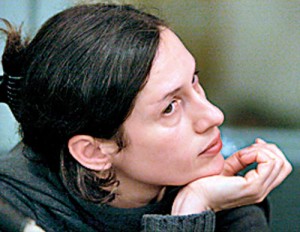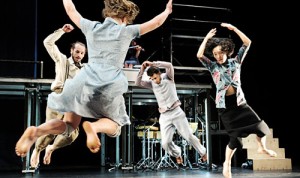Disparate memories dancing to the tune of the show’s language
Constanza Macras has only been in Colombo for a day and two nights when we meet – but she tells me her questionnaires came before her. The choreographer of ‘The Past,’ Macras is fascinated by how we remember things. Her noisy, challenging production was staged for Colombo audiences later that evening and as she has done in the cities that came before, Macras attempted to localise the piece by incorporating answers garnered from her questionnaires. In them she had asked people about their relationship to the tangible reality of their cities. Colombo is fascinating to her; with its beautification schemes, its ongoing gentrification and its scars from the long conflict.

Constanza Macras
Throughout the production, the idea that memory is rooted in physical constructs is a strong theme, as is the exploration of how memory survives when its original context is destroyed. The memories that Macras initially set out to work with were drawn from four interviews with survivors of the bombing of Dresden in 1945 – a nightmare of four raids over three days in mid-February when the allies dropped more than 3,900 tonnes of bombs and incendiary devices on the city. A cast made up of nine dancers and actors offered interpretations of the memories and meditations of Macras’ four interviewees at different points in their lives.
Macras tells the Sunday Times that her interviewees were of different ages and had had, as a consequence, differing experiences of the war. What they all had in common though was the urge to talk – in length, over hours – with her. Their memories of their homes (the white piano in the corner and much dreaded practice sessions), their strange neighbours (the Japanese woman who danced the bon odori beautifully, outside in the cold, dressed only in her underwear), their dislike of picnics (oh, you poor thing, you have to eat outside, said his mother) are among a set of beautiful, short narratives. However, when it comes to incorporating a Sri Lankan story, Macras’ choices appear to be more of a token gesture than genuine engagement with what would have otherwise been a rich trove of material.

the dancers in motion
Ruvin de Silva, who along with Indian actor Kanchan Bhattacharyya, served as a guest performer, was given only a brief few minutes on stage to speak in very general terms of the post-war Sri Lankan identity, Sinhala Buddhist nationalism, and the recent rejection of communalism and corruption by the electorate. World Bank policies were referred to, but not personal experiences. The storytelling that made the Dresden excerpts so intimate and interesting were nowhere in evidence.
Moving on, Macras’ script combines the excerpts from her interviews with cultural and historical examinations of how memory works. For the ancient Greeks architecture could be brought into the service of memory, the very structure of a house being a key device in deploying the art of mnemonics. It is said young men learning long speeches would walk through a building, associating each new line or theme with a room, object or structural element such as a staircase or a window. When later delivering the speech, they would simply need to move methodically through the structure again, remembering those visuals to trigger recall of every line.
Macras toys with this, as she sets her dancers to reliving memories that are no longer anchored in real world landmarks. These memories are marked by the slow upheaval of old age and bereavement and the immediate chaos of war and conflict.Room is even made for a digression in to the nature of time – time is abstract, variable, it is actually change that we take notice of, argues Luc Giol who delivers some of the performance’s most eccentric and passionate monologues.
The dancing itself is by phases disjointed and beautiful, a medley of styles ranging from ballet to hiphop. (One performer in particular is startling and strange – a contortionist, tall and thin, he has an almost androgynous appeal and unfurls himself from out of a bag.) In some particularly effective sequences, dancers appear to loop and stutter as memories are replayed over and over again.
The music deserves a mention. Played live by the talented duo of Miako Klein and Yuka Ohta, the soundtrack composed by Oscar Bianchi incorporated violin, recorders and percussion among a dozen other improvised instruments. Ohta coaxed screeches and scrapes, low thrumming and pops from objects as varied as a thick sheet of plastic, a small satellite receiver dish and a bathtub. In parts the show got painfully, and perhaps purposefully, loud – launching an all-out auditory assault of people shouting, of flutes being played in discordant symphony, of general mayhem.
I go home with mixed feelings about the performance, but still thinking about how such disparate elements made for a relatively cohesive whole. It is also a reminder of something Macras said while describing the work of Dorky Park that morning, a summation of what she sees as the troupe’s strength and which audiences have now seen for themselves: “Everyone [on the show] works within this style. You can see where people come from, but there’s a language that belongs to the show really because we did it together.”


